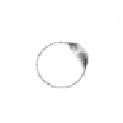Biomedical Engineering Reference
In-Depth Information
(a)
(b)
(c)
(d)
(e)
Figure 12.
Weak boundary enhancement: (a) original image with partial weak edge; (b)
gradient of original image; (c) new image after enhancement; (d) segmentation result using
a front-evolving model on original image; (e) segmentation result using a front-evolving
model on the enhanced image.
The extrema of the above form are in the directions of the eigenvectors of the
metric tensor, with corresponding eigenvalues
s
xx
+
s
yy
±
(
s
xx
−
s
yy
)
2
+4
s
xy
λ
±
=
.
(12)
2
In the image, the maximal and minimal changes at a specific location are
provided by the eigenvalues
λ
±
. Different functions of
λ
±
could be used to define
the edges. In our approach, we define the following equation:
=
e
−ρ∗
(
λ
+
−λ
−
)
,
F
(13)
where
ρ
is a constant. When we place this speed factor into the Eikonal equation,
|∇
T
|
F
=1, themoving front will stop at the locationwhere
F
is small enough—in
another words, where the difference between
λ
+
and
λ
−
is large enough.
In order to prove the proposed edge enhancement, consider the example de-
picted in Figure 12. From this image, a big difference can be observed. Without
using the weak boundary enhancement, the evolving front will move out of the
dark region from the weak edge; after applying the enhancement, the moving front
is stopped by the enhancement and it successfully accomplishes the segmentation
without leakage.
From this microscopic imaging segmentation, the reader may find difficulty
in using the edge-based method in some special cases where the objects have a
very weak boundary. The method used in the above cell segmentation is only one
example. Many attempts have been made to enhance image contrast so that the
boundary information will be strong enough to stop the moving front, as with Lee's
sigma filter [51], nonlinear anisotropic diffusion [52], the heat and shock filter [53],
among others. These methods have to provide the intra-regional smoothing while
enhance the inter-regional contrast, so that the moving front is able to move over
small speckles of the noise and stop at the boundary of the big region.






